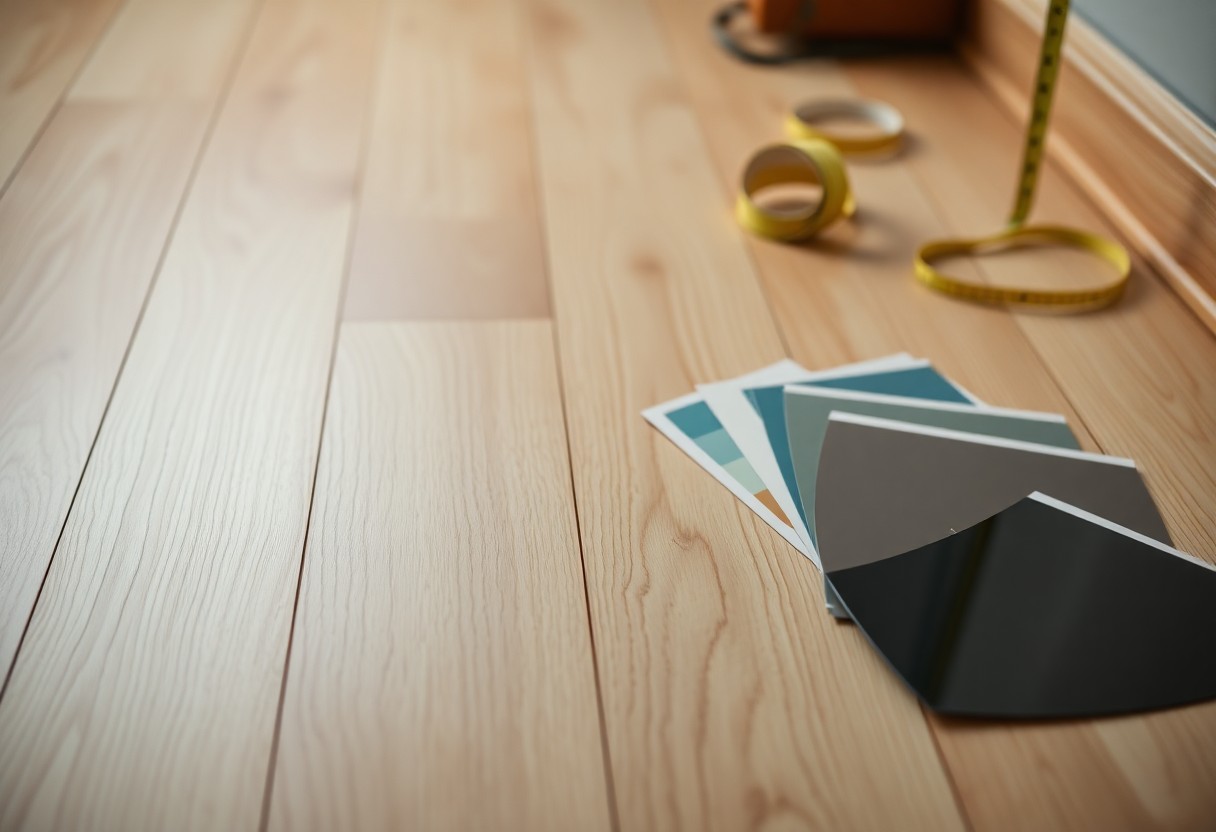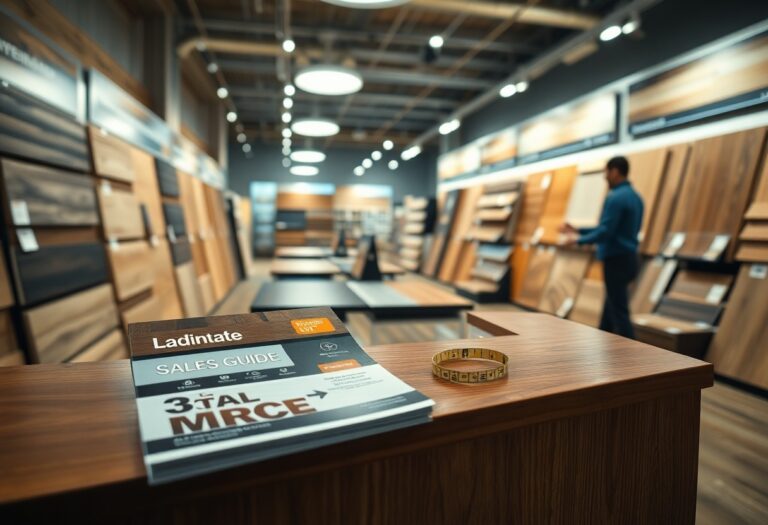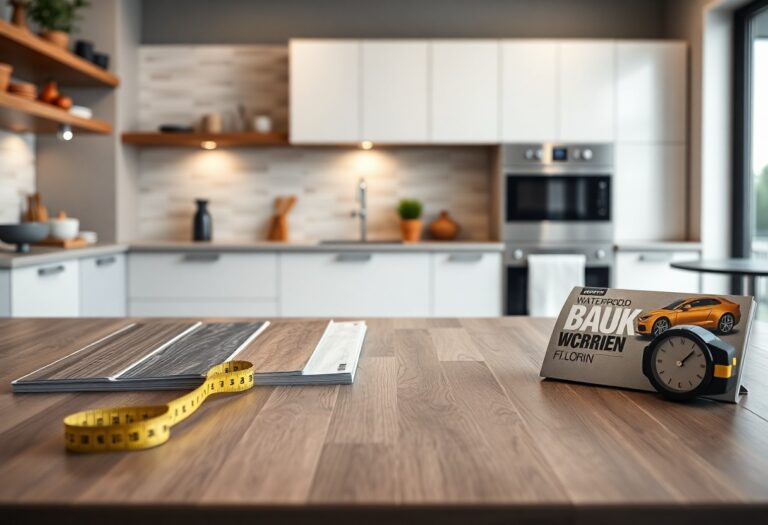This guide will help you navigate the various finishing options for your white oak hardwood floors. Selecting the right finish not only enhances the natural beauty of the wood but also protects it from wear and tear. You’ll learn about different types of finishes, their benefits, and how to choose one that suits your lifestyle and aesthetic preferences. By the end of this comprehensive guide, you’ll feel confident in making the best decision for your home.
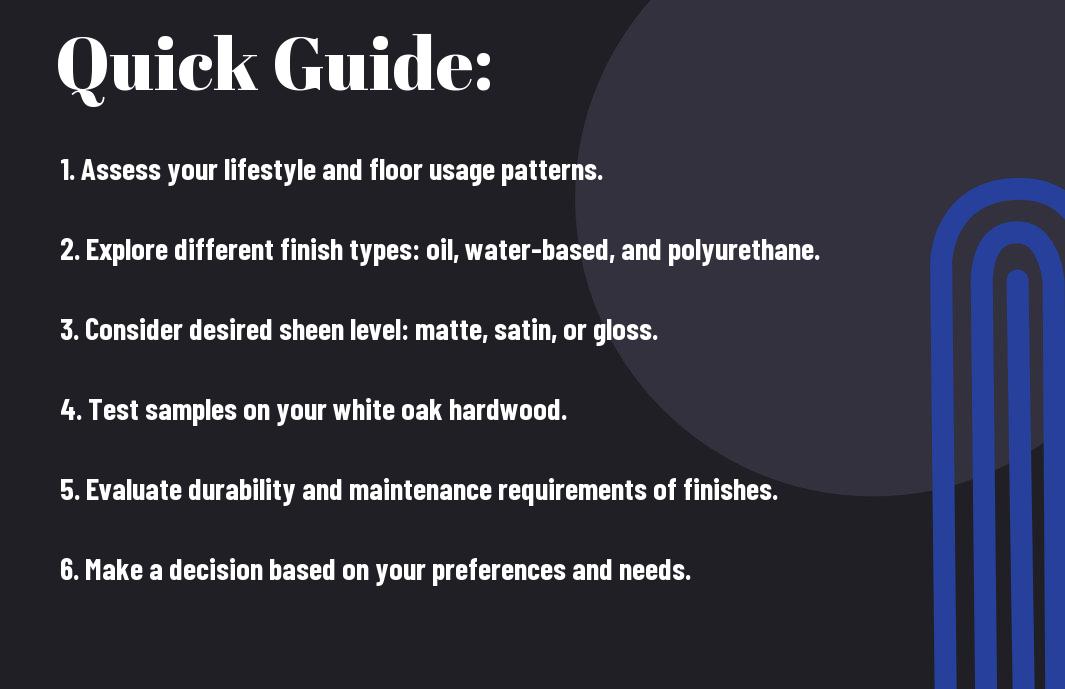
Understanding White Oak Hardwood Floors
While selecting flooring, it’s important to understand white oak hardwood. Known for its durability and rich aesthetic, white oak provides a timeless appeal that complements various interior designs. Its fine grain and warm tones can elevate any space, making it a popular choice for homeowners. With proper care, white oak floors can also stand the test of time, ensuring they remain a valuable feature in your home for years to come.
Characteristics of White Oak
Even though white oak may appear similar to other hardwoods, its unique characteristics set it apart. Featuring a distinctive grain pattern, white oak is naturally resistant to moisture and decay, making it an excellent choice for different environments. Its light to medium brown hue provides versatility, allowing you to achieve the perfect look for your living spaces.
Benefits of Choosing Hardwood Floors
Any time you invest in hardwood flooring, you’re choosing a material that combines beauty and longevity. Hardwood floors not only enhance the aesthetic value of your home but can also be beneficial for your health. Unlike carpet, hardwood floors do not trap allergens, making your indoor air quality significantly better.
Hardwood is a sustainable option, as many manufacturers source their materials responsibly. Additionally, these floors offer exceptional durability, resisting dents and scratches better than many other flooring types. The ability to refinish them means you can refresh their appearance rather than replacing them entirely, which not only saves you money but also supports an eco-friendly approach. Ultimately, choosing hardwood floors enriches your living space while providing lasting benefits.
Types of Finishes for White Oak
The options available for finishing your white oak hardwood floors can significantly impact their appearance and durability. Here’s a quick overview of the various finish types:
| Finish Type | Description |
| Oil-Based Finishes | Rich color, durable, and provides a warm glow. |
| Water-Based Finishes | Quick-drying, low odor, and offers a clear finish. |
| Penetrating Oils | Deeply penetrates wood, enhancing natural grain. |
| UV-Cured Finishes | Quick curing under UV light, highly durable. |
| Alkyd Finishes | Combines oils and resins for a hard, glossy finish. |
Any choice you make should align with your desired aesthetic and maintenance preferences.
Oil-Based Finishes
There’s a reason oil-based finishes are popular—you get a rich color and enhanced durability that truly showcases your white oak flooring. These finishes tend to amber over time, adding a certain warmth that complements the wood’s natural tones.
Water-Based Finishes
Little maintenance is needed with water-based finishes, making them a practical choice for busy households. They dry quickly and have a clear finish that preserves the authentic look of your white oak floors.
The low odor and environmental benefits also make water-based finishes an excellent option. They are less toxic and provide a quicker return to indoor activities after application, making them a perfect choice for those looking for efficiency and safety.
Penetrating Oils
To achieve a natural look on your white oak, consider penetrating oils. These finishes deeply penetrate the wood, enhancing its grain without creating a thick layer on top.
It’s vital to note that penetrating oils require more frequent reapplication to maintain their protective qualities. However, they allow for easy repairs and touch-ups, keeping your floors looking fresh and vibrant without the hassle of a complete refinishing job.
UV-Cured Finishes
Finishes cured by UV light provide an incredibly durable surface that withstands wear and tear effectively. These quick-curing options keep your white oak floors looking pristine while allowing for instant use after application.
A notable benefit of UV-cured finishes is their resistance to scratching and chemicals, ensuring your floors can handle everyday life. This makes them a fantastic choice for homes with kids or pets, offering both beauty and resilience without compromising on aesthetics.
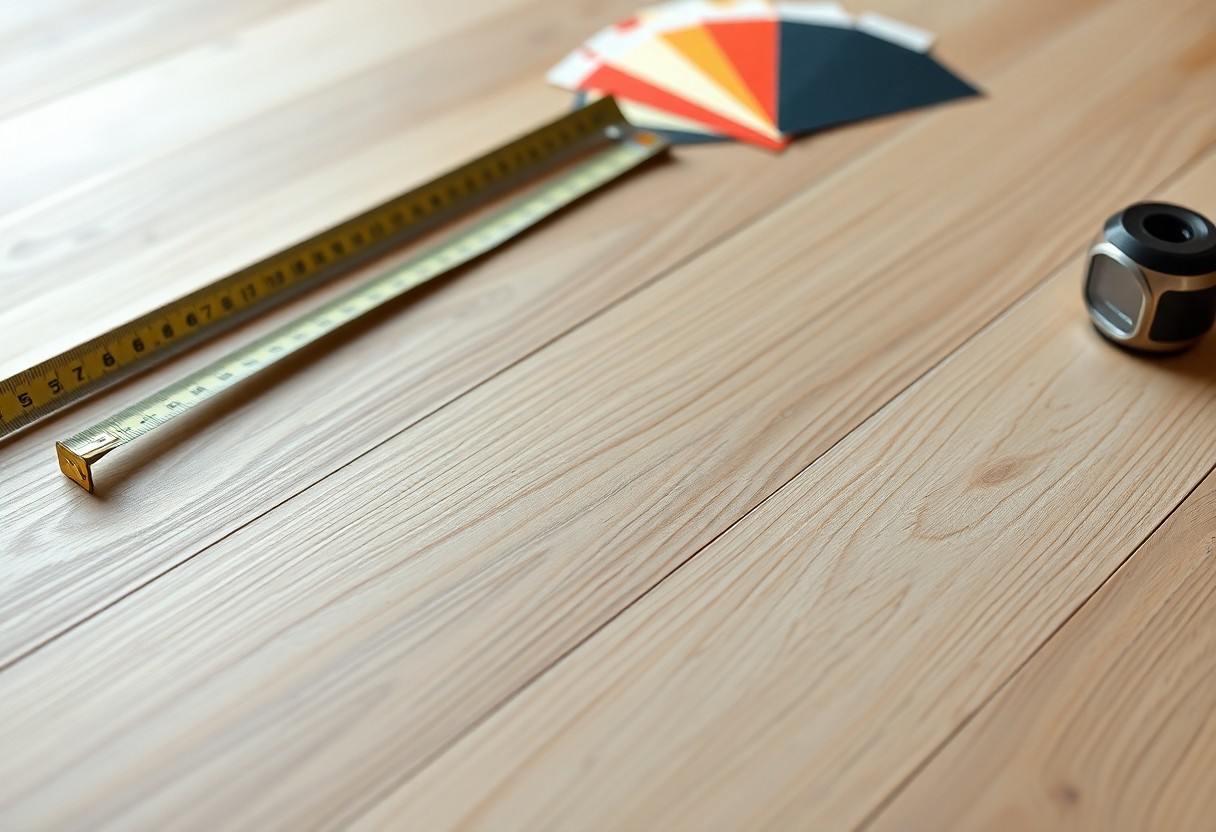
Factors to Consider When Choosing a Finish
For homeowners, selecting the perfect finish for your white oak hardwood floors involves multiple factors that can impact the end result. Consider the following:
- Durability
- Sheen level
- Environmental impact
- Application method
Knowing these factors will help you choose a finish that complements your lifestyle and enhances the natural beauty of your hardwood floors.
Lifestyle and Usage
Factors you need to weigh heavily on include the amount of foot traffic your floors will experience. If your household is bustling with kids and pets, a more durable finish may be necessary to withstand wear and tear. On the other hand, if your space sees light use, you might opt for a more delicate finish that accentuates the wood’s character.
Aesthetic Preferences
Lifestyle plays a significant role in your finish selection. Your personal style—whether modern, rustic, or traditional—can guide your choice, as the right finish can enhance visual appeal while also complementing your home’s existing decor.
Consider how the sheen and color of the finish affect the overall aesthetic of your space. A high-gloss finish may create a contemporary look, while a matte or satin finish can add warmth and depth, perfect for a cozy ambiance. Additionally, feel free to experiment with different finishes to find the one that truly resonates with your design sensibilities.
Maintenance Requirements
For any finish you consider, it’s necessary to evaluate how much upkeep you’re willing to commit to. Some finishes require regular reapplication or stringent cleaning methods, while others allow for more flexibility in maintenance routines.
The level of maintenance you choose will not only affect the longevity of your floors but also how often you need to devote time to their care. High-gloss finishes, while stunning, may reveal scratches more easily and thus require more regular upkeep, whereas an oil-based finish might offer a more forgiving surface with less visible wear and tear over time.
Step-by-Step Guide to Applying Finish
After you have selected the ideal finish for your white oak hardwood floors, it’s important to apply it correctly for optimal results. Follow this step-by-step guide to ensure a smooth application process.
| Steps | Description |
|---|---|
| 1. Preparing the Floor | Thoroughly clean and inspect your floor before applying any finish. |
| 2. Choosing the Right Tools | Select appropriate tools for the application of the finish. |
| 3. Application Techniques | Use proper techniques for applying the finish evenly and efficiently. |
Preparing the Floor
Floor preparation is a vital step in the finishing process. Begin by sweeping and vacuuming thoroughly to remove dust and debris. Inspect the surface for any imperfections, repairing them as necessary to ensure a smooth application.
Choosing the Right Tools
Step by step, selecting the right tools will make the finishing process more efficient and yield superior results.
With the right tools at your disposal, you can greatly enhance the quality of the finish. Common tools include a quality paintbrush, roller or applicator, and sanding equipment. Choosing high-quality, professional-grade tools will help achieve a more even coat and make the application process easier and more enjoyable.
Application Techniques
The methods you use to apply the finish can significantly affect the outcome of your hardwood floor.
Preparing for the application requires careful consideration of techniques. Use smooth, even strokes to apply the finish, starting from one corner and working your way toward the exit. This approach minimizes the risk of stepping on freshly finished areas, ensuring an even and streak-free application throughout the floor.
Tips for Maintaining Finished Floors
Now that you’ve selected the perfect finish for your white oak hardwood floors, maintaining their appearance and durability is key. Follow these guidelines to ensure longevity:
- Regularly clean with a soft broom or vacuum.
- Avoid harsh chemicals and water saturation.
- Use furniture pads to prevent scratches.
- Control humidity levels in your home.
- Immediately wipe spills to prevent staining.
Perceiving the value of these maintenance practices will help you keep your floors looking beautiful for years to come.
Regular Cleaning
One of the simplest ways to maintain your hardwood floors is through regular cleaning. A soft broom or vacuum specifically designed for wood floors will effectively remove dust and dirt without scratching the surface.
Avoiding Damage
For your hardwood floors to remain intact, it’s important to avoid common causes of damage. Implement measures such as placing rugs in high-traffic areas and using protective pads on furniture legs to reduce the risk of scratches.
This proactive approach not only preserves the finish but also extends the life of your floors. Being cautious with wet cleaning methods and avoiding excess moisture can further safeguard against issues like warping or buckling, ensuring your investment remains protected.
Periodic Reapplication
Any hardwood floor finish requires periodic reapplication to maintain its protective qualities. Routine assessments will help you determine when it’s time to refresh the finish.
It’s beneficial to schedule this process every few years, depending on foot traffic and wear. By applying a new layer of finish, you can restore the original luster and enhance the durability of your floor, keeping it beautiful and functional for many more years.
Pros and Cons of Different Finishes
Keep in mind that choosing a finish for your white oak hardwood floors involves weighing various pros and cons. Each finish type has unique characteristics which can impact durability, maintenance, and appearance. The table below summarizes key advantages and disadvantages of the most common finishes.
| Finish Type | Pros | Cons |
|---|---|---|
| Oil-based Polyurethane | Durable, strong protection | Long drying time, strong odor |
| Water-based Polyurethane | Quick drying, low odor | Less durable, can raise wood grain |
| Penetrating Oil | Natural look, easy to apply | Needs reapplication, limited surface protection |
| Varnish | Highly durable, glossy finish | Strong chemicals, longer curing time |
| Lacquer | Fast-drying, high-gloss finish | Less heat/scratch resistant |
| Wax | Beautiful sheen, easy to repair | Requires frequent maintenance |
Advantages of Each Type
With various finishes available, you can cater to your specific preferences and lifestyle requirements. For instance, oil-based polyurethane offers unmatched durability, while water-based options provide a quicker application process. If you favor a natural aesthetic, penetrating oil enhances the wood’s grain beautifully. Each finish presents unique benefits that can enhance your home’s elegance and practicality.
Disadvantages to Consider
Even though each finish comes with its advantages, there are notable downsides to consider. For example, oil-based polyurethane, while durable, has a long drying time and emits strong fumes. Conversely, water-based finishes are quicker to dry but usually offer less protection and can raise the grain of your wood. Being aware of these disadvantages will help you make a more informed decision on the right finish for your floors.
To effectively navigate these disadvantages, it’s crucial to evaluate your lifestyle and expectations. If you have a busy household, finishes that require constant upkeep—like wax—might not suit your needs. Furthermore, if you’re sensitive to chemical exposures, you may want to skip oil-based products. Analyzing how these limitations align with your day-to-day living can guide you toward making the best choice for preserving and enhancing the beauty of your white oak hardwood floors.
Conclusion
Drawing together the insights from this comprehensive guide, selecting the right finish for your white oak hardwood floors involves careful consideration of your lifestyle, aesthetic preferences, and maintenance capabilities. By weighing the benefits of various finish types—such as oil-based, water-based, or polyurethane—you can enhance your flooring while ensuring its durability. Prioritize your needs and preferences to make an informed decision that not only beautifies your space but also protects your investment for years to come.


